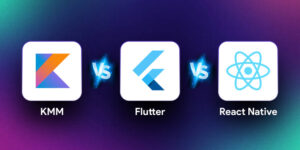
Cross-platform development is transforming the app development business in 2026. With the most recent technology, including Flutter, React Native, Kotlin Multiplatform, and .NET MAUI, software creators save time, expenses and deliver frequent experiences on mobile, web, and desktop applications. This blog presents the best tools and trends that will shape the future of cross-platform development in 2026.
Consumers in this digital world want a seamless and consistent experience on all of the devices that they touch: smartphones, tablets, desktops, and wearables. For a business, and particularly those building enterprise or manufacturing applications, providing such consistency is no longer optional, but a necessity
The concept of cross-platform development is not what it was in the old days. What used to be criticised as a slow and inefficient product now delivers almost native speed, eye-catching design, and seamless features on all big platforms.
The year 2026 will be a turning point. The innovations in frameworks, integration of clouds and AI-based tools have changed the way developers build across various operating systems. It is no longer a dream to build once and deploy everywhere.
What is Cross-Platform Development?

Cross-platform development is the development of software that executes on several platforms based on one or a largely common codebase. Rather than creating individual apps in Android, iOS, desktop, and web, now developers can create a single app and run it in all environments.
This strategy provides a number of distinct benefits:
- Shared Codebase: You have a single business logic and UI elements, which makes updates simple and minimizes bugs.
- Shortened Time to Market: Apps will be released on all platforms at once.
- Reduced Costs: It reduces the overall development costs as there is less redundancy with fewer teams.
- Greater Accessibility: Your application can be utilized by people on multiple devices: smartphones, tablets, desktops, and even the Internet of Things.
For businesses, this is agility and efficiency. For developers, this will result in a more predictable workflow and simplified maintenance. However, it all depends on choosing the right framework and architecture for your objectives.
Why Cross-Platform Matters in 2026
Cross-platform development has become a strategic requirement. The reasons are clear:
- Performance is Now Comparable to Native:
Frameworks such as Flutter and React Native offer almost native performance, with smooth animations and predictable memory management.
- Single Experience on Multiple Devices:
Applications now need to perform effectively on phones, desktops, smart TVs, and AR/VRs. A common codebase provides visual and functional consistency.
- Artificial Intelligence and Edge Computing:
AI is needed in modern applications to provide features like AI, offline and data-driven insights. The advanced technologies are easier to integrate using cross-platform frameworks.
- Improved ROI:
A single development project will serve more than one channel, and this reduces the cost and the value of your investment in the long term.
In manufacturing or enterprise business, the effect is enormous. Applications are able to track machines, oversee workflows, and visualize analytics across devices without maintaining individual codebases.
Top Tools and Frameworks to Watch in 2026

1. Flutter (by Google)
Flutter is still among the strongest cross-platform development frameworks. It is an open-source, mobile, web, and desktop developer platform that enables developers to build beautiful and high-performance apps using the same codebase. Its expressive UI controls, fast hot-reload and smooth rendering engine are appropriate to enterprise-scale applications.
For companies that develop complex dashboards or applications deployed in the web and mobile environment, Flutter offers a stable performance and design flexibility.
3. React Native (by Meta)
React Native remains a popular choice among teams which use JavaScript or React to write web applications. It allows quick prototyping, robust community support, and cross-platform.
React Native makes the move to mobile much easier, and most of the same logic can be reused in businesses that already have existing web apps. It works particularly well with MVPs, internal applications, and customer-facing applications requiring rapid development.
3. Kotlin Multiplatform & Compose Multiplatform
Kotlin Multiplatform has gained serious traction by allowing developers to share business logic across Android, iOS, web, and desktop while still creating native UIs where necessary.
Compose Multiplatform takes it further by supporting shared UI components. This balance between shared and native development is perfect for large enterprise systems where both flexibility and native performance are required.
For example, manufacturing companies can use it to share logic for production monitoring across devices but still tailor the UI for mobile operators and desktop supervisors.
4. .NET MAUI (Multi-Platform App UI)
.NET MAUI offers a cross-platform method of creating applications using C# to organizations that have already invested in Microsoft technologies. It covers both mobile, desktop, and web with common logic and similar performance.
It is the most suitable product to integrate with Azure and other Microsoft products in case of an enterprise ecosystem where one cares about security, scalability and compatibility with a backend.
5. Lightweight Tools: Tauri and Beyond
A newer generation of lightweight frameworks is emerging for cross-platform desktop apps. Tauri, for example, allows developers to create apps using a Rust backend and web-based front-end, producing smaller, faster applications than older frameworks like Electron.
These tools are ideal in an internal dashboard, industrial control interfaces and companion desktop applications which must be both efficient and secure.
Key Trends Shaping Cross-Platform Development in 2026

1. AI-Driven Development
AI is no longer a feature but the core of applications. AI is now applied by developers to predictive UX and automation, code generation and testing. AI is being deeply incorporated into cross-platform frameworks, with applications being able to provide smarter prediction of personalization and offline analytics, as well as more intelligent automation, and even a shared codebase.
For example, an AI-driven manufacturing app can identify machine malfunctions, propose maintenance, and notify managers across all devices with ease.
2. Multi-Device Continuity
Apps are expected to cross-link devices without problems. One can start working on a mobile phone and shift to a tablet, and finish the work on a desktop without losing the information and context.
Such continuity is now being developed into cross-platform systems and allows a business to develop multi-screen workflows to increase productivity and engagement.
3. Modular and Composable Architecture
The developers are giving up on heavy, monolithic codebases. Rather, the apps are now constructed out of modular, composable units that can be reused across projects.
This modular architecture accelerates updates, enables parallel development, and enhances maintainability. For businesses, it means that it will become quicker to deliver and easier to scale as new devices or features are included.
4. Focus on Performance, Privacy, and Sustainability
Performance is not negotiable anymore. Applications should be quick to load, consume less energy and be functional even in low-end gadgets. Meanwhile, privacy policies and user trust have taken centre stage.
Developers are incorporating privacy-by-design concepts, such as reducing the amount of data collected, ensuring privacy in communication and processing, where they can be done locally.
Cross-platform tools are assisting the teams in fulfilling these requirements without compromising the speed and UX.
5. Rise of Low-Code and No-Code Platforms
Speed is one of the leading business priorities. Low-code and no-code frameworks are now important in getting apps to market quicker, particularly internal tools and prototypes. These platforms are frequently cross-platform based, that is, the developers can develop visual builders alongside custom code where necessary.
This hybrid method ensures flexibility and saves development cycles significantly. For app development companies, the ability to build custom, industry-specific templates or existing modules can become a new source of revenue.
Conclusion
In 2026, cross-platform development is no longer a shortcut; it is a strategic enabler. The structures are more advanced, the tools are smarter, and the outcomes are evident; they deliver fast, cost less, and can be used on all devices.
To a mobile app development firm, particularly one that caters to manufacturing and business clients, the incorporation of cross-platform tools is not merely the means of generating less code. It is all about providing unified digital ecosystems, which connect the shop floor, the office and the cloud together, in one cohesive experience.
The future of app development is integrative, smart and hardware-agnostic. The ones who are able to master cross-platform strategies nowadays will be the market leaders tomorrow.






